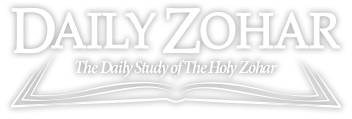Daily Zohar # 3974 – Behaalotcha – They are backward to keep us straight
Daily Zohar 3974

Hebrew translation:
128. בֹּא רְאֵה, נ’ בְּאַשְׁרֵי יוֹשְׁבֵי בֵיתֶךָ לֹא נֶאֶמְרָה, מִשּׁוּם שֶׁהִיא בַּגָּלוּת, וַהֲרֵי פֵּרְשׁוּהָ הַחֲבֵרִים, שֶׁכָּתוּב (עמוס ה) נָפְלָה לֹא תוֹסִיף קוּם בְּתוּלַת יִשְׂרָאֵל וְגוֹ’. אֶלָּא מַה כָּתוּב לְמַעְלָה? וַאֲרוֹן בְּרִית ה’ נֹסֵעַ לִפְנֵיהֶם דֶּרֶךְ שְׁלֹשֶׁת יָמִים לָתוּר לָהֶם מְנוּחָה. כֵּיוָן שֶׁהָיָה נוֹסֵעַ הָאָרוֹן, נוּ”ן נוֹסַעַת עָלָיו (עִמּוֹ), וַהֲרֵי הַשְּׁכִינָה יוֹשֶׁבֶת עַל גַּבֵּי הָאָרוֹן. בֹּא רְאֵה חֲבִיבוּת הַקָּדוֹשׁ בָּרוּךְ הוּא לְגַבֵּי יִשְׂרָאֵל, שֶׁהֲרֵי אַף עַל גַּב שֶׁהֵם סוֹטִים מִדֶּרֶךְ הַיָּשָׁר, הַקָּדוֹשׁ בָּרוּךְ הוּא לֹא רוֹצֶה לְעָזְבָם, וּבְכָל זְמַן מַחֲזִיר פָּנָיו לְמוּלָם, שֶׁאִם לֹא כָּךְ, לֹא יַעַמְדוּ בָעוֹלָם.
.
Zohar Behaalotcha
Continued from previous DZ
#127

Rabbi Elazar said, here, one has to look at the letter’ נ.’ That she turns her face back here in two places; the “נ” that is the ‘נ,’ which precedes and after the parashia (Numbers 10:35) “וַיְהִי בִּנְסֹעַ הָאָרֹן וַיֹּאמֶר מֹשֶׁה קוּמָה יְהוָה וְיָפֻצוּ אֹיְבֶיךָ וְיָנֻסוּ מְשַׂנְאֶיךָ מִפָּנֶיךָ.”
“So it was, whenever the Ark set out, that Moses said: “Rise up, O YHVH! Let Your enemies be scattered, And let those who hate You flee before You.”
And if you say that it alludes to a bent “נ,” which is known as Nukva, that is Malchut. The stretched “ן” are male and female, Zeir Anpin and Malchut.
We learned that “Moses said: “Rise up, O YHVH!” is to raise the bent “נ.” The question is why the two “נ” turn backward as a kind of inverted “נ.”
#128
The letter “נ” is not found in the order of the letters in Psalm 145 because the “נ is Malchut in exile and represents falling, as we read in Amos 5:2
“נָפְלָה לֹא תוֹסִיף קוּם בְּתוּלַת יִשְׂרָאֵל נִטְּשָׁה עַל אַדְמָתָהּ אֵין מְקִימָהּ.”
“The virgin of Israel has fallen; She will rise no more. She lies forsaken on her land; There is no one to raise her.”
Just before the inverted “נ,” we read;
Numbers 10:33
“וַיִּסְעוּ מֵהַר יְהוָה דֶּרֶךְ שְׁלֹשֶׁת יָמִים וַאֲרוֹן בְּרִית יְהוָה נֹסֵעַ לִפְנֵיהֶם דֶּרֶךְ שְׁלֹשֶׁת יָמִים לָתוּר לָהֶם מְנוּחָה.”
“So they departed from the mountain of YHVH on a journey of three days, and the ark of the covenant of YHVH went before them for the three days’ journey, to search out a resting place for them.”
When the Ark travels, the “נ” that is Malchut, the Shechina, is sitting on the Ark.
Because of the love of the Holy One, Blessed be He, to Israel, even though they strayed from the straight path, he doesn’t want to leave them. He always shows his face to them because otherwise, they would never be able to rise again.
Lesson;
The Nun represents Malchut which is in a state of falling, and the Shechinah is in Malchut to support us. The two Nuns bring the Shechina and Malchut to be close to the Ark, where the Torah tablets are placed. The Torah is Zeir Anpin, and the verses between the Nun support the unification of Zeir Anpin and Malchut. The words “קומה ה'” “Rise, O YHVH!” help Malchut and the Shechina to rise for the unification with Zeir Anpin. The final Nun is stretched down and represents both Zeir Anpin (Male) because the top part of the letter is vav ‘ו,’ and the letter is stretched down below the baseline to indicate female.
{||}

 Previous: Behaalotcha
Previous: Behaalotcha
